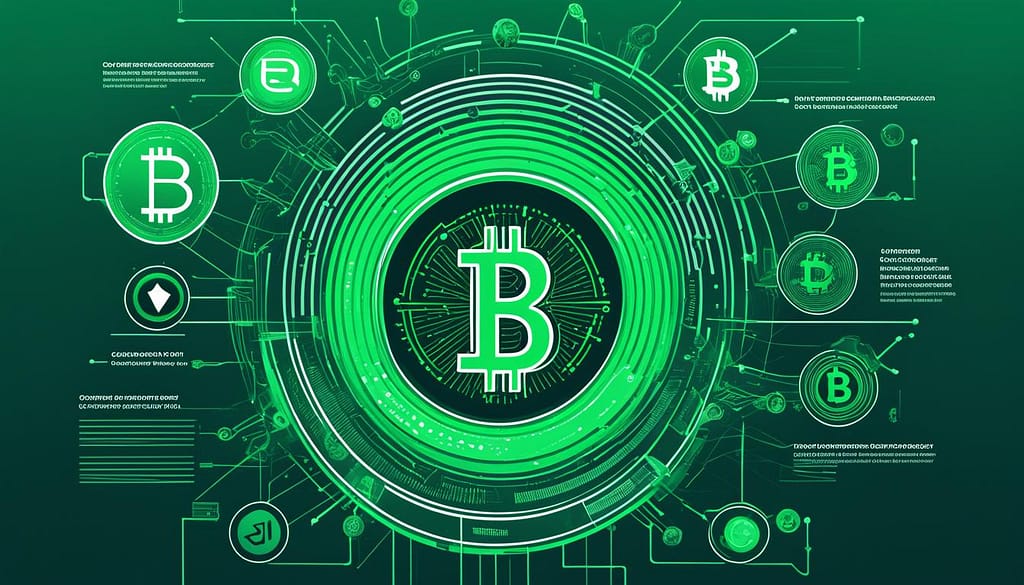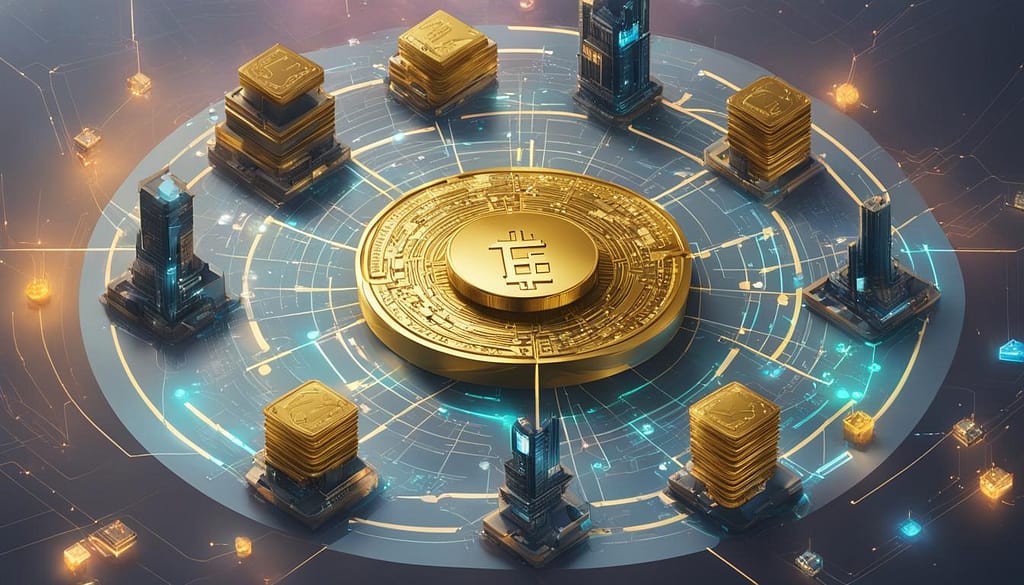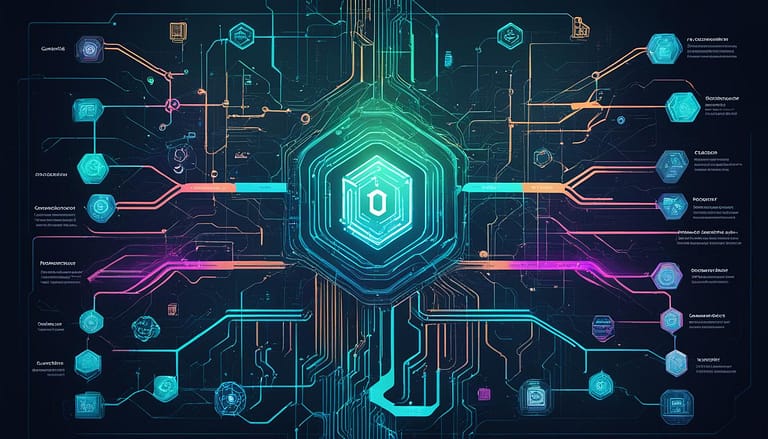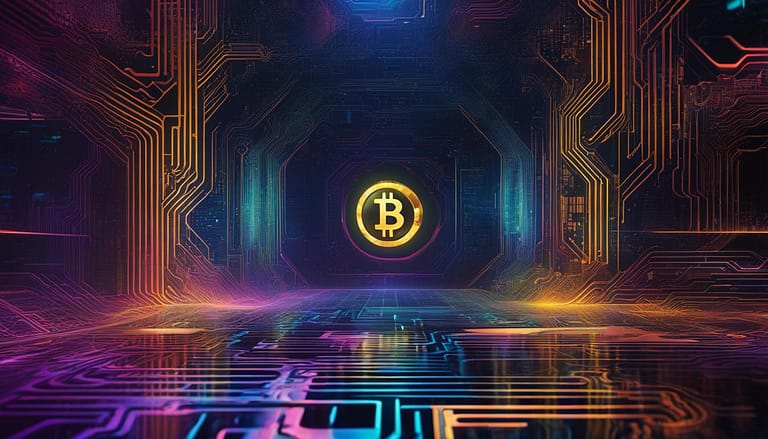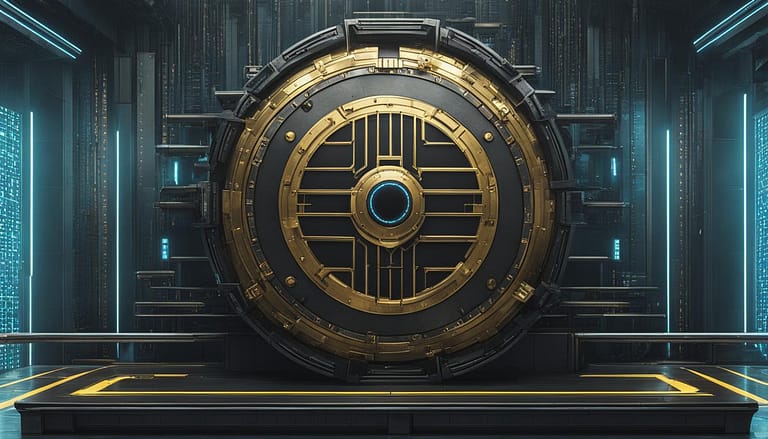What is DAI?
In the ever-evolving world of cryptocurrency, the emergence of DAI coin as a stablecoin has marked a significant milestone in the industry. As a crypto asset entrenched in the ethos of decentralized finance (DeFi), DAI operates on the Ethereum blockchain with a steadfast commitment to mirroring the value of one United States dollar, providing both stability and versatility in a single virtual currency. By employing advanced blockchain technology, DAI has transcended the conventional confines of digital currencies, presenting a compelling option for users who seek consistency amidst the volatile crypto market.
This radical approach to creating a digital currency that bridges the gap between the virtual and the real-world economies has placed DAI as an integral player in the complex machinery of decentralized finance. Leveraging this sophisticated platform, DAI’s unrivalled protocol operates within the open-source fabric of the Ethereum blockchain, making it a cornerstone asset in the portfolio of any crypto enthusiast seeking stability in their digital transactions.
Key Takeaways
- DAI is a forefront stablecoin on the Ethereum blockchain, pegged closely to the USD for financial stability.
- It champions the principles of decentralized finance, providing an alternate financial system without a central authority.
- DAI is not just a digital currency but also a crypto asset that represents innovation in blockchain technology.
- The Ethereum blockchain is foundational to DAI, enabling smart contract functionalities that govern its operation.
- DAI upholds the ethos of virtual currency, focusing on transparency and consistency in value.
- It is engineered to operate autonomously, driven by smart contracts and the collective actions of its users.
The Genesis of DAI: A Stablecoin Revolution
In the landscape of digital currencies, the concept of a stablecoin has emerged as a cornerstone of decentralized finance (DeFi). Stablecoins promise the benefits of a crypto asset without the typical volatility that plagues the cryptocurrency market. Among them, DAI stands out as a herald of the stablecoin revolution, confirming its significant role within the DeFi movement. Rune Christensen and MakerDAO’s vision birthed a digital currency that fundamentally alters our perspective on financial autonomy and stability.
Understanding the Concept of Stablecoins
The entire idea of a stablecoin is to merge the decentralized, borderless nature of cryptocurrencies with the stable value of traditional fiat currencies, forming a versatile digital currency that retains purchasing power. The DAI stablecoin exemplifies this by mastering the balance between the innovative Ethereum blockchain technology and the stable value pegged to the US dollar.
The Birth of DAI: A Decluttered Financial Approach
Unique to the stablecoin landscape, DAI entered the DeFi sphere in 2014 as a product of the Maker Protocol. Unlike other stablecoins secured by central entities or fiat collaterals, DAI is underpinned by a decentralized ethos, with its stability generated through a basket of diversified crypto asset collaterals. This approach not only attests to the security and transparency accorded by DeFi but also represents MakerDAO’s innovative foresight into a decluttered financial future.
DAI’s Unique Position in the Cryptocurrency Ecosystem
DAI’s position in the cryptocurrency ecosystem is indeed peculiar. It is not just another crypto asset; it is a testament to the power of decentralized finance. The MakerDAO-operated DAI stablecoin challenges conventional financial models, serving as a beacon for the sustainable, trustless, and inclusive stablecoin revolution that the innovative Maker Protocol has set in motion. DAI’s unlimited supply capacity—responsive to market demands and collateral provisions—reinforces its singular stance as a truly decentralized digital currency.
The strategic investment from Andreessen Horowitz, among others, has not only instilled confidence in the MakerDAO ecosystem but has also spotlighted DAI’s remarkable potential for growth and innovation in the dynamic DeFi market.
Decentralized Finance (DeFi) and DAI’s Role
The rise of decentralized finance (DeFi) marks a significant shift in the world of finance, opening doors to financial inclusivity and democratization like never before. At the heart of this burgeoning sector is DAI coin, a stablecoin pegged to the US dollar, built on the resilient Ethereum blockchain. DAI’s unique properties contribute profoundly to the ethos of the digital currency landscape, providing a viable crypto asset for users keen on avoiding the volatility traditionally associated with cryptocurrencies.
The autonomous and transparent operations of the DAI system within the Maker Protocol portray the true spirit of DeFi by enabling permissionless and seamless financial transactions. Here, individuals have the power to mint new DAI coins by locking up collateral, which signifies a step away from centralized banking systems and a movement towards a trustless financial ecosystem.
DAI’s ability to provide stability in the digital currency market while being fully integrated into the decentralized finance model illustrates the potential of DeFi to reconstruct the financial world.
- Permissionless access to financial services
- Greater transparency and reduced counterparty risk
- Unprecedented access to a stable digital currency
- Innovative DeFi applications bolstering financial inclusivity
Moreover, the diverse utilization of DAI across various decentralized applications (dApps) on the Ethereum network showcases its adaptability and indispensability within the DeFi landscape. As we forge ahead, DAI is not just a financial instrument, but a catalyst in the ever-expanding realm of decentralized finance, remoulding our interaction with the very concept of money.
How DAI Maintains Its One Dollar Parity
Maintaining a tight linkage with the US dollar, DAI coin has become a cornerstone in the realm of decentralized finance. Integral to its stability is the synergy between user-driven collateral deposits and the intelligent design of MakerDAO’s smart contracts. Situated firmly on the Ethereum blockchain, DAI remains resilient even amidst the intrinsic volatility of the cryptocurrency market.
The Role of MakerDAO’s Smart Contracts
Enabling the one dollar parity of DAI, smart contracts serve as unbiased arbitrators that govern the issuance and backing of this novel digital currency. These contracts are encoded with the rules laid out by MakerDAO, to ensure a calculated overcollateralization. Thus, each token of DAI is robustly backed by assets to withstand market fluctuations.
Collateralization Explained: The Backbone of DAI Stability
The collateralization ratio is a critical metric within the DAI ecosystem, mandating that deposited collateral—such as Ethereum—must surpass the value of minted DAI. This safeguard persists as users interact with the platform, providing an essential buffer against rapid economic shifts. MakerDAO closely monitors and adjusts these ratios to ensure DAI’s anchor to the dollar is not merely a pledge, but an executed reality.
The following table illustrates the vital parameters factored into maintaining the stability of DAI:
| Parameter | Description | Impact on Stability |
|---|---|---|
| Collateralization Ratio | Minimum value of collateral required for DAI issuance | Buffers against volatility, ensuring DAI remains overcollateralized |
| Interest Rates | Cost of borrowing DAI against collateral | Regulates demand for DAI, affecting its parity with USD |
| Governance | Community votes on protocol changes | Allows dynamic adjustments in response to economic conditions |
As fluctuations in value are inherently tied to both the cryptocurrency market and traditional finance realms, DAI exemplifies stability crafted through technical sophistication and proactive governance—a true product of an evolving decentralized landscape.
An In-depth Look into DAI’s Collateral Loans
The evolution of decentralized finance has introduced groundbreaking financial products, and among them, DAI coin stands out with its collateral loan services. Born from the innovative MakerDAO platform, DAI embodies the versatility of a digital currency while upholding the principles of a transparent and equitable financial system enabled by smart contracts.
Securing a DAI collateral loan is a seamless process on the Ethereum blockchain. Users lock in their cryptocurrency as collateral, which activates the minting of DAI. The key to this system’s reliability is the requirement for overcollateralization. Essentially, the value of the assets held in a smart contract must exceed the value of the DAI loaned. This strategy is a bulwark against the notorious volatility of the cryptocurrency market, aiming to ensure lenders can recover their assets even in a downturn.
“DAI collateral loans offer users access to liquid funds while allowing them to retain potential gains from their cryptocurrency investments”
What sets DAI collateral loans apart in the decentralized finance space is their non-restrictive nature and potential for interest earnings. Users seeking to leverage their cryptocurrency holdings for immediate liquidity without relinquishing their positions find DAI loans to be an invaluable tool. Furthermore, these loans open doors to various applications, including:
- Participation in DeFi platforms
- Asset diversification without cashing out one’s investment
- Engaging in blockchain-based gaming and virtual goods economies
This detailed examination of DAI collateral loans demonstrates not just the practical utility they provide to individual users, but also the innovative ways in which the MakerDAO and the broader Ethereum ecosystem are promoting financial inclusivity and flexibility.
DAI Coin: An ERC-20 Token Built on Ethereum
The DAI coin represents a groundbreaking integration of cryptocurrency and decentralized finance (DeFi), functioning as an ERC-20 token within the expansive Ethereum blockchain. As a digital currency, DAI coin has become synonymous with stability and innovation, offering seamless compatibility with an array of crypto exchanges and wallets due to the ERC-20 standard it employs. Its role as a significant crypto asset extends beyond mere currency as it underpins a vast network of smart contracts and is pivotal to the operations of MakerDAO, a cornerstone entity in DeFi.
As users contemplate the complexities of blockchain technology, understanding DAI’s token specifications is crucial. These technicalities are not just for developers; they influence the entire ecosystem where DAI operates. Below we present a detailed table that elucidates different aspects of DAI as an ERC-20 token on the Ethereum platform:
| Feature | Description |
|---|---|
| Token Standard | ERC-20 |
| Blockchain Platform | Ethereum |
| Key Functionality | Serves as stable digital currency within Ethereum’s DeFi landscape |
| Interoperability | Widely compatible with various digital wallets and exchanges |
| Governance | Led by MakerDAO, offering a decentralized decision-making process |
| Smart Contracts | Facilitate minting, stability, and transactions of DAI coins |
| MakerDAO’s Role | Oversees risk management and protocol adjustments for DAI |
DAI’s seamless assimilation into the ecosystem displays the formidable synergy between cryptocurrencies like DAI coin, smart contracts, and the principles of decentralized finance. The efficiency and fluidity with which DAI coin operates underscore the innovation that the Ethereum blockchain and MakerDAO bring to the financial world, allowing DAI to not just adapt but thrive amidst the rapidly evolving digital economy.
The stability and functionality of DAI coin reaffirm the Ethereum blockchain’s capability as a foundation for complex protocols that expand the horizons of what decentralized systems can achieve. Integrating such versatility with transparent and democratic financial processes, MakerDAO and DAI coin collectively reflect the transformative potential within today’s burgeoning cryptosphere.
MakerDAO: The Decentralized Autonomy Behind DAI
The democratization of finance is a pivotal aspect of MakerDAO, an organization that has been instrumental in shaping the landscape of decentralized finance (DeFi). Through the innovative use of the Ethereum blockchain, MakerDAO has been able to steer the development and maintain the stability of the DAI coin, a popular cryptocurrency that relies on decentralization for its operations.
Maker’s History and Vision for Decentralized Finance
At the heart of MakerDAO lies a vision that transcends the traditional financial paradigms — one that embraces the core concepts of accessibility, transparency, and community governance. By leveraging the Maker Protocol, MakerDAO has allowed users to generate DAI coins by engaging with its ecosystem, built on the Ethereum blockchain. The seamless integration of blockchain technology with a stablecoin system signifies MakerDAO’s progressive approach to finance. This platform is powered by users holding the governance token, MKR, a testament to the authentic decentralization that is often aspired to but rarely achieved in the cryptosphere.
How Governance in MakerDAO Influences DAI
The unique governance structure introduced by MakerDAO empowers owners of MKR tokens to assert their voice in the crucial decisions that affect the system’s parameters and, by extension, the stability of the DAI coin. Be it amending the risk parameters, incorporating new collateral types under the Maker Protocol, or adjusting system fees; these democratic processes ensure the adaptiveness and resilience of DAI in an ever-evolving cryptocurrency market.
Decentralization is not just a concept but the very lifeblood that drives MakerDAO, enabling every participant to play a role in the governance while building an inclusive financial environment. This approach has yielded a robust framework within which DAI continues to thrive, propelling the DeFi movement forward and solidifying the essence of true economic empowerment.
The Mechanics of DAI: CDPs and Their Function
Understanding the innovative framework of DAI coin is paramount for stakeholders in decentralized finance. At the heart of this system is MakerDAO, incorporating a crucial element known as Collateralized Debt Positions (CDPs). These are essentially smart contracts on the Ethereum blockchain that serve as foundational tools for users looking to interact with DAI as a digital currency and crypto asset. CDPs provide a secure method for users to deposit their assets as collateral and, in turn, mint DAI coins.
These secured “vaults” operate based on a meticulous system of smart contracts, enhancing the fluidity and adaptability of the DAI ecosystem. Over-collateralization is a distinctive feature of CDPs, permitting the DAI currency to maintain stability even amid the inherent volatility of the crypto market. Below is an outlined structure that embodies the efficacy of CDPs within MakerDAO’s construct:
- Collateral Submission: Users pledge a certain amount of Ethereum or other accepted assets into the CDP.
- DAI Generation: Equivalent DAI coins are minted against the collateral, ensuring a liquid capital provision while maintaining ownership of the underlying assets.
- Stability Assurance: By requiring over-collateralization, CDPs protect against adverse price movements and anchor DAI’s value.
- Asset Recovery: Users retain the ability to reclaim their collateral after repaying the DAI, along with any associated fees.
Ultimately, CDPs are a manifestation of the stable and user-centric approach adopted by DAI and MakerDAO. They facilitate a seamless, decentralized finance experience, thereby consolidating DAI’s position as a leading digital currency on the Ethereum blockchain.
Securing the Value of DAI: Risk Mitigation Strategies
As a cornerstone of the resilient MakerDAO ecosystem, DAI coin stands as a testament to advanced risk mitigation techniques in the volatile world of cryptocurrencies. Trust in DAI as a reliable stablecoin is achieved through continuous enhancements in security measures and protocols on the Ethereum blockchain.
Audits and Formal Verification for Enhanced Security
To instill confidence among users and investors, comprehensive security audits are conducted regularly. These intricate checks are designed to probe the integrity of the smart contracts that form the operational bedrock of DAI. Moreover, formal verification methodologies are employed to mathematically prove the correctness of these protocols against their specifications, ensuring that DAI remains steadfast against threats and vulnerabilities.
Emergency Shutdowns: A Fail-Safe for the DAI Ecosystem
In the unlikely event of systemic risks or unforeseen disasters, the MakerDAO architecture includes a crucial feature: emergency shutdowns. This extraordinary measure acts as a comprehensive circuit breaker for the DAI monetary system, preserving the value and redemption of the stablecoin even amidst dire circumstances.
| Risk Mitigation Component | Function | Benefit to DAI Users |
|---|---|---|
| Security Audits | Examination and evaluation of smart contracts. | Enhanced trust in the system’s integrity. |
| Formal Verification | Mathematical proof of protocol correctness. | Guaranteed functioning as designed, without flaws. |
| Emergency Shutdowns | Safeguard mechanism against systemic failure. | Protection of assets and stability of DAI coin. |
The laudable dedication of MakerDAO towards incorporating such protective measures showcases their commitment to not only maintain but also foster faith in DAI as a pioneering cryptocurrency on the landscape of the Ethereum blockchain.
Utilizing DAI in the DeFi Sector
As a beacon of stability within the tempestuous world of cryptocurrency, DAI coin stands out as a preferred digital currency for crypto trading, especially on the Ethereum blockchain. Its inherent design as a stablecoin means it doesn’t suffer the same volatility as other cryptocurrencies, making it critical for operating within the decentralized finance (DeFi) networks. The applications in the DeFi landscape benefit significantly from DAI’s stability, allowing for more predictable financial planning and risk management in a sector known for its rapid fluctuations.
In the context of DeFi applications, DAI provides an alternative to traditional banking services. It enables decentralized borrowing, lending, and yield farming platforms to exist without the direct oversight of central financial institutions. These platforms extend the essence of decentralized finance by offering open access to financial services for individuals globally, eliminating barriers such as physical location and opening hours and reducing the reliance on the credibility of central intermediaries.
| Features of DAI | Advantages in DeFi |
|---|---|
| Stable Value Peg | Reduces volatility risk for traders |
| Decentralization | Democratizes access to financial services |
| Ethereum Blockchain Integration | Facilitates smart contract-based applications |
| Open-Source Protocol | Enables innovation and auditability |
| Accepted Collateral for Loans | Enhances lending and borrowing services |
| Utility in DeFi Ecosystem | Serves as a preferred currency for transactions and savings |
The unique properties of DAI have made it an integral component of the DeFi space, particularly for those looking to engage in crypto trading without exposure to potentially adverse market movements. This digital currency acts as a cornerstone for the burgeoning DeFi sector, providing the stable groundwork necessary for the ecosystem to continue its expansive and innovative growth.
Conclusion
Embarking upon a reflection of the transformative journey DAI coin has taken within the financial landscape, it is clear that its role extends beyond that of a mere digital currency. As a lynchpin in the domain of decentralized finance (DeFi), DAI has set a new standard in the realm of stablecoins. Its meticulous design to mirror the value of the U.S. dollar, powered by the security and innovation of the Ethereum blockchain, has significantly contributed to the quest for financial stability in the often tumultuous cryptocurrency market.
DAI exemplifies the values entrenched in DeFi by showcasing how a crypto asset can offer the same level of trust and stability as traditional financial systems, if not more. Governed by the principles of MakerDAO, its decentralized framework assures users of transparency and control over their financial dealings, thereby democratizing access to financial services. This is no small feat in an ecosystem that is rapidly evolving, where DAI has continually demonstrated adaptability and resilience.
The success story of DAI is a testament to the incredible potential that blockchain technology holds for the future of finance. As it integrates more deeply into various sectors, it offers a blueprint for how digital currencies can be designed to promote stability and confidence among users. In conclusion, MakerDAO’s DAI is not simply a stablecoin—it is a pivotal innovation within DeFi that underlines the foundational role of blockchain technology in sculpting a more accessible and equitable financial framework for all.
FAQ
What is DAI?
How does DAI maintain its value?
What is the difference between DAI and other stablecoins?
Can anyone generate DAI?
What is MakerDAO?
What role does the Ethereum blockchain play in the DAI ecosystem?
What are Collateralized Debt Positions (CDPs)?
How are DAI transactions secured on the blockchain?
What are the benefits of DAI in the DeFi sector?
Is the supply of DAI limited?
Source Links
- https://en.wikipedia.org/wiki/Dai_(cryptocurrency)
- https://www.gemini.com/cryptopedia/dai-stablecoin-what-is-dai-token
- https://kriptomat.io/cryptocurrencies/dai/what-is-dai/



